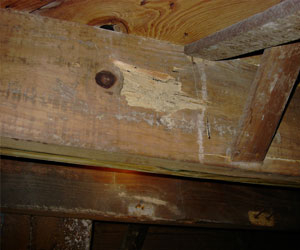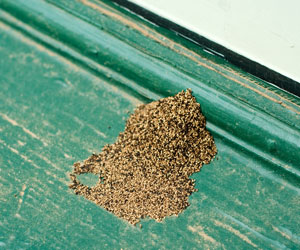What are the Signs of Termite Damage?
Termite damage is without a doubt one of the most common and frustrating pest problems homeowners and businesses face. In a high-risk area, your home is more likely to be damaged by termites than fire. Termites actually cause over $5 billion in property damage every year, according to statistics from the National Pest Management Association (NPMA).
Termites are tough insects with an insatiable appetite for wood and plant matter. These pesky pests chew quickly through wood, weakening structures and wreaking havoc in your home. In addition to wooden materials, they are capable of traversing through vinyl, laminate, plaster, metal siding and more; and it only takes a short period of time for them to do major damage to walls, foundations, floors, cabinets, ceilings and wooden furniture within the affected buildings.
As a home or commercial building owner, it is important that you have your property inspected for signs of termite damage regularly. This is particularly important if you are in an area that is susceptible to termites. If you suspect that your home or building is affected by termite activity, you should contact local pest control professionals as soon as possible. This is because it is best to catch the problem quickly to avoid major structural damage that could be costly to fix. Pest control experts can identify even the less obvious signs of termite damage and treat an infestation accordingly.

Signs of Termite Damage
- 1. Buckling or hollow-sounding wood: Termites usually excavate and feed on wood from the inside, leaving hollowed out wood that looks solid on the outside but is actually hollow under the surface.
- 2. Sagging or spongy floor: Termite may feed on laminate flooring materials and even skirting boards, causing the affected areas to blister and sag, or feel spongy.
- 3. Swollen or cracked ceilings: Termites feast on wooden ceilings, beams, architraves and rafters in attics, leading to cracks on ceilings and cornices.
- 4. Discolored areas on wood: Termite-infested wood may experience change of color or appearance. In most cases, the wood may become darker and take on the appearance of a stain. The affected wooden areas may also appear to puff up or blister, which is another telltale sign of termite damage.
- 5. Cracked or distorted paint on various wood surfaces: Termites can enter through extremely small openings, such as the cracks near roof siding, vents and windows, as well as in the home's foundation. The termite damage resulting from this can be observable through buckling paint or tiny holes on wood.
- 6. Irregular or misshapen window and door frames: Termites often feed on wooden window and door frames, thereby causing them to become irregular and misshapen. The damage and tunneling by termites may also cause the affected windows or doors to become difficult to open.
- 7. Mud tubes on walls: Termites (subterranean species) build mud tubes on surfaces, including on walls, foundations and even on ceilings, in order to get moisture while they are searching for food.
- 8. Swarmers: Reproductive subterranean termites, usually referred to as swarmers, take flight to build new colonies. So if you see a swarm of ants or piles of wings, it may be an indication that a nest may be near and there may be resultant termite damage.
- 9. Live termites: While searching for evidence of termite damage, be sure to keep an eye out for the insects themselves. Live termite sightings and swarming is an obvious evidence of their presence; and any evidence that there are termites in and around your property is a good indication that there could be damage.
- 10: Frass or fecal matter: Drywood termites tend to keep their tunnels clean inside the wood by creating holes to discard their fecal pellets, also called frass. So if you see these wood-colored droppings on walls or furniture, it may be an indication that you have an active colony that could be causing damage to your property and you should contact a pest control professional to inspect the severity of the damage, as well as remedial treatment options.
